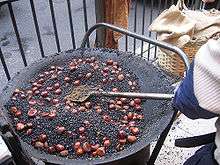Hot salt frying
Hot salt frying and hot sand frying are cooking techniques used by street-side food vendors in Pakistan, China and India.[1] Hot sand frying is one of the oldest cooking techniques in the world, and is used in villages throughout Asia and other parts of the world.
Hot salt frying
In Pakistan, hot salt frying is mostly used by street vendors to cook corn. Rock salt is preheated in a wok. Either the whole corn or individual kernels are buried in the salt and occasionally turned.
Coarse sea salt is placed in a large wok and heated to a high temperature. Dry food items, such as eggs in shell, are buried in the hot salt and occasionally turned with a spatula.
In India,[1] this technique is used by street vendors selling shelled peanuts or popcorn cooked in salt heated in an iron wok.
At times beef steak is fried in this manner - by preheating the frying-pan and salt and the placing steak on it on one side for a minute and then on the other side for two minutes depending on the thickness and how well one wants it.
Hot sand frying

Hot sand frying is a common cooking technique[2] for street-side food vendors in China and India to cook chestnuts and peanuts. A large wok is filled with black sand and heated to high temperature. Nuts are buried in the hot sand and occasionally turned with a spatula, then the sand and nuts are separated through a wire-mesh screen. Hot sand frying is also used in many villages throughout Asia. A common cooking technique in Villages is to wrap fish or other meat in a banana leaf, tie it off, and then place the banana leaf in the heated sand one side at a time. Puffed rice is also a common snack in India and is one of their oldest foods. The puffed rice is made by heating sand in a wok over a fire in a traditional indian stove, then pouring the rice into the sand and quickly stirring the rice. The puffed rice is then quickly removed with a metal seive and set to cool. Many other foods are fried with Hot sand, even in common households because it is a healthy, oil free, cheap way to cook without needing any fancy household appliances such as an air cooker.
See also
References
- 1 2 "Technique: Hot Salt Frying". Foodista. Retrieved 21 June 2013.
- ↑ "Cooking School". Cooking School Info Site (website). Accessed May 2010. Archived March 6, 2012, at the Wayback Machine.